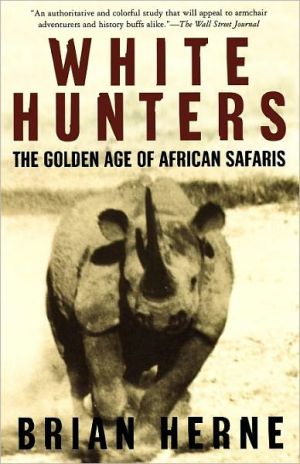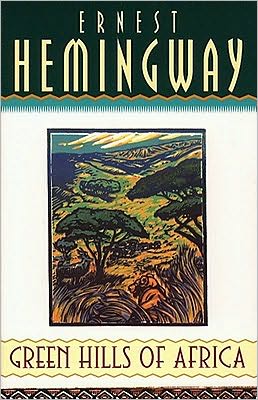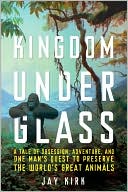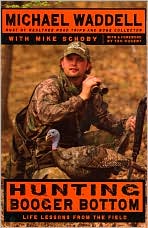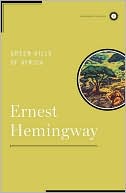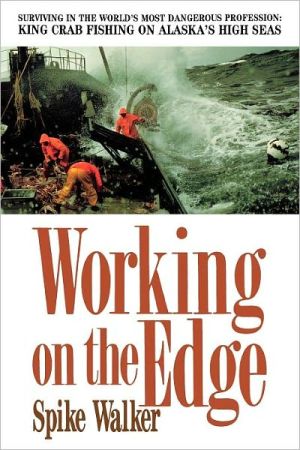White Hunters: The Golden Age of African Safaris
East Africa affects our imagination like few other places: The sight of a charging rhino goes directly to the heart; the limitless landscape of bony highlands, desert, and mountain is, as Isak Dinesen wrote, of "unequalled nobility." White Hunters is the story of seventy years of African adventure, danger, and romance. It re-creates the legary big-game safaris led by Selous and Bell and the daring ventures of early hunters into unexplored territories, and brings to life such romantic figures...
Search in google:
East Africa affects our imagination like few other places: The sight of a charging rhino goes directly to the heart; the limitless landscape of bony highlands, desert, and mountain is of "unequalled nobility," writes Dinessen. The adventures recorded here lasted only seventy years but include the legendary big-game safaris led by Selous and Bell; early hunters who by necessity were explorers; the Hill cousins, J. A. Hunter and Ionides; Cape-to-Cairo Grogan, who walked 4,000 miles for the love of a woman; Bror Von Blixen and the romantic Denys Finch. Their exploits inspired Hemingway's stories and movies with Clark Gable and Gregory Peck. Animal lovers, these hunters were the first conservationists, witnesses to the richest wildlife spectacle the earth has ever known. Brian Herne, formerly a professional hunter and one of the few awarded the Shaw and Hunter Trophy, evokes the harmony that existed between hunters and big game before poaching and politics intervened. White Hunters summons adventure, danger, and romance on a grand scale. Salon - Scott Sutherland On May 20, 1977, the government of Kenya banned big-game hunting in an attempt, the official line went, to preserve the wildlife that had become a major tourist draw. No more rifles, Nairobi said; from now on, Kenyan safaris would be conducted with binoculars and cameras. The '70s were an overdue period of environmental consciousness-raising throughout the Western world, and to most Americans and Europeans the edict from Kenya was welcome. But the news from Africa is rarely as clear-cut as it first appears. As Brian Herne argues in White Hunters, the real threat to Kenyan wildlife lay in poaching, which was widespread, indiscriminate and often conducted with the help of corrupt Kenyan game officials. The conservation-minded big game hunters were an easy target, though, and the hunting ban, still in place, abruptly ended a colorful if somewhat blood-spattered period of East African history. The demise of big game hunting in Kenya -- and in the Sudan, Uganda, Tanzania and Zaire -- occupies the final chapters of Herne's book, but it's a shame he didn't make it his primary subject. Herne, a second-generation Kenyan and himself a professional or "white" hunter (so called because virtually all of them were of European descent) for 30 years, might have injected his tale with a host of compelling post-Colonial story lines and told it from the perspective of an active participant -- but he does not. Instead he offers an exhaustive social history of the professional (and largely Anglo) hunting fraternity, from its Victorian beginnings to its heyday in the '50s, '60s and '70s. Vivid tales of cunning, bravery and foolhardiness abound, but Herne, apparently intent on historical completeness, goes on burnishing the legend long after it has achieved peak elegiac glow. Of the book's 49 chapters, it's the final two, with an accompanying epilogue, that resonate most deeply. Still, many of Herne's anecdotes of life on safari stalking the Big Five -- lion, leopard, rhino, buffalo and elephant -- are spellbinding, as when 1960s-era white hunter Ian MacDonald confronts a wounded leopard: The big cat immediately went for Ian's throat ... He swore and cussed and attacked the growling cat with his bare hands, grabbing it by the throat as [the leopard's] jaws locked on his forearm ... Somehow he got the cat in an armlock stranglehold, hoping to choke it, but the cat went berserk and broke free, sinking its fangs into Ian's arm ... As the battle raged, Ian punched the leopard and the two thrashed about in a bloody melee. A shredded dew claw from Ian's first shotgun blast ... hooked into the white of MacDonald's left eye... And so forth. MacDonald's Masai tracker eventually rushed in to dispatch the cat with a machete blow to the back; the hunter, stitched up in a Nairobi hospital, was back in the bush in less than a month. Herne isn't the least bit interested in analyzing his bwanas' sense of entitlement. He prefers to pepper his tales of bloody derring-do with amusing stories of the rich and famous on safari, notably their sexual entanglements: "Even when [Edward, Prince of Wales] was on safari his attention was easily diverted by female company. At Dodoma...the prince disappeared into the night with the wife of a junior official, then turned up several hours late for a formal dinner." Aside from occasional nuggets, though -- such as Queen Victoria's bestowing Mount Kilimanjaro upon Kaiser Wilhelm for his birthday, the 1920s practice of treating the dreaded blackwater fever with massive ingestions of champagne, white hunters' role in the bloody Mau Mau uprisings of the 1950s -- the profiles that make up the vast midsection of Herne's book follow a predictable pattern: A notable white hunter is introduced and his various qualities listed; he goes on safari with a rich or famous client, who inevitably botches the kill; the quarry flees into a thicket, with the white hunter hot on its tracks; the beast, wounded and royally pissed off, launches a surprise counterattack and proceeds to maul, horn, tusk, eviscerate or otherwise distress the hunter, who desires only to put it out of its misery. Most of these encounters end with the survival of the hunter. A few, in spectacularly gruesome fashion, do not. Herne traces the history of the hunters' conservation efforts, making a strong case at the close for the return of hunter-influenced game management in East Africa, where over the past three decades poachers armed with military assault rifles have decimated the game population. "The simple uncontrovertible fact is that in countries with a per capita income of a few hundred dollars a year, there is little hope for the rhinoceros when the current price fetched by its horn is more than $30,000 per pound," Herne concludes. Of East Africa and the golden age of safaris, he asks, "Paradise lost? Perhaps." After the final chapters of White Hunters, though, that "perhaps" seems like a vastly over-optimistic answer.
White Hunters\ The Golden Age of African Safaris \ \ By Brian Herne \ Owl Publishing Company\ Copyright © 2001 Brian Herne\ All right reserved.\ ISBN: 0805067361 \ \ \ \ \ Chapter One\ \ \ THE FIRST WHITE HUNTERS\ \ \ In the late nineteenth century the deserts of north Somaliland, or the Land of Punt, as it was sometimes called, ran from the Gulf of Aden to the Horn of Africa, then south to the Juba and Tana rivers where they spilled into the Indian Ocean. It was truly terra incognita, the land of devil dervishes, dust storms, and, it was said, fiendish beasts. Fierce Somali clans roamed this unmapped territory of heat, thirst, and sudden death. Despite such formidable obstacles superb hunting could be had east of Suez, just a few miles into the interior from the sultry port of Berbera. Somaliland's northern coast lay along the direct sea route between England and its Indian empire, thereby making it accessible to a handful of intrepid Victorian adventurers.\ Early foreign hunters drawn by the Land of Punt's inexorable romance, mystique, and danger included British army officers stationed in India. Almost all of these amateur hunters set out with the object of bagging a lion. Some were successful, but the lions in many cases kept the score fairly even, mauling or killing many of thesedaring souls. Hunting was, of course, a long cherished tradition during the Victorian and Edwardian eras in England, just as it was on the European continent and in the United States.\ Although the term "white hunter" actually had its beginnings in British East Africa after the turn of the twentieth century, big game hunting was already popular in other parts of the "Dark Continent," notably in South Africa, where amateur and meat hunters, as well as a few ivory hunters, had been active long before Somaliland and East Africa came into vogue. In South Africa the exploits of adventurers such as Gordon Roualeyn Cumming, William Cornwallis Harris, and Charles Baldwin, to name just a few of that era's prolific South African nimrods, were the stuff of legends. These men were after meat mostly; some were hide or tusk hunters, but all proved capable of remarkable feats of endurance, regardless of quarry. In Cumming's book, The Lion Hunter of South Africa, for example, there is a sketch of Cumming swimming in the water alongside a giant hippopotamus, armed with nothing but a sheath knife. His intentions are clear--he is attempting to dispatch the "sea horse," or at least secure it by cutting hand-hold slots in the unfortunate hippo's hide. He titles the sketch, "Waltz with a Hippo."\ \ \ * * *\ Cornwallis Harris was a magnificent painter and a fearless hunter who cut the trails of countless "ferocious beasts." Charles Baldwin wrote a memorable account of his own stirring exploits in the pursuit of big game circa 1852-1860. These South African hunters all remained amateur hunters, not white hunters, who were professionals.\ In German East Africa, Carl Georg Schillings, a hunter and a gifted naturalist, had made a series of safaris to the German colony beginning in 1896. Schillings was also an innovative photographer who took great risks to secure some of the earliest pictures of African game. He once stalked to within fifteen yards of a mud wallow to photograph two rhino. Another time he was charged by an agitated herd of elephant and had to shoot his way out of the fix. He experimented with flashlight photographs, having mixed his own flash powder at no little risk. Under the most primitive conditions Schillings developed his massive photographic plates, experimented with some of the earliest telephoto lenses, and explored most of the north-central part of the colony. He took particular interest in the country around Kilimanjaro, and some of his best wildlife photographs were shot across the border in British East around the soda lake at Amboseli. Schillings's pictures of lions taken at night with his infamous flash powder are classics to this day. He was also a fine ornithologist and made a great collection of birds, many of them hitherto unknown. His handsome two-volume book, With Flashlight and Rifle, was first published in Berlin and translated into English in 1906. The books were received with great acclaim in Europe and aroused an unprecedented interest in the German colony.\ Around 1900 there were fair numbers of white settlers, mostly farmers living in the Rhodesias, who occasionally took friends out for a spot of shooting. Such hunts were normally casual, disorganized affairs. "Shooting" was still the operative word, rather than "hunting."\ One of the best pioneer Rhodesia-based hunters was the immensely experienced Marcus Daly, who was sufficiently opportunistic to be regarded as both a professional white hunter and an ivory hunter. He began his career as a game trapper near the Zambezi River catching animals to stock Cecil Rhodes's Kenilworth Zoo in England. Daly roamed across Africa, taking paying clients when he could get them, hunting ivory for himself when he could not. He was an accomplished hunter who had a reputation for physical ferocity. Marcus Daly was known to have a habit of sending bullets whistling dangerously close to the feet of uninvited guests to his camp, particularly government officials, whom he loathed on sight. Daly hunted for a while in British East as well as other African countries, and he was friendly with early Nairobi white hunters Bill Judd and Tom Murray Smith, who was later to become president of the East African Professional Hunter's Association.\ Some competitive resentment naturally arose between professional hunters operating in different areas. Marcus Daly, for one, must have resented the special aura that attached itself exclusively to the hunters of East Africa, for he wrote, "The term white hunter is a purely Nairobi manufacture and was never heard of in Rhodesia where all the best hunters are found."\ Whether Marcus Daly liked it or not, the white hunters of Nairobi were a breed apart. Lionized by Ernest Hemingway and Robert Ruark, it was the white hunters of British and German East Africa who came to be portrayed on movie screens around the world.\ \ \ * * *\ Modern day authorities hold divergent views on the subject of just who should be accorded the title of Africa's first white hunter. There is equal uncertainty about precisely who first coined the term, but what is certain is that the term "white hunter" has been in common use in East Africa since the turn of the century.\ Emily Host and colonial historians accord the honor of first white hunter to either R. J. Cunninghame or Bill Judd. White hunter Donald Ker emphatically states it was Alan Black. J. A. Hunter maintained that it was the Hill cousins. It could even be argued that one of the first white hunters was in fact no stiff-upper-lipped Victorian, but a Texan with the grand name of Peregrine (Peary to his clients) Herne. In the 1840s Herne (no relation to the author) roamed the wilderness of the American West, making a living hunting and trapping. At the trading station called Brown's Hole on the Green River, upstream from the Colorado, Herne's path crossed that of an English sportsman, a gentleman of fortune named Robert Barrill. The two men became fast friends, and Barrill proposed that as an "experienced hunter" Peregrine Herne should accompany him to various parts of the world. As Herne wrote, "If I would accompany him on his travels and hunting expeditions, he would take care that I was well provided in every respect." Herne gladly accepted, and may actually have been the first white hunter from that era to have been paid for his services, which included hunting in Africa. In any event Herne's "guiding" activities closely resembled those of this century's first white hunters.\ By several reliable accounts it was the chance meeting of hunter Alan Black and a reckless amateur hunter known as "D," the fiery Lord Delamere, that led to the term "white hunter." Delamere had employed the youthful Alan Black to help out on one of his Somaliland safaris in the late 1890s. When Delamere settled in British East Africa he purchased very large acreages of ranching country. At the time he employed a Somali hunter to shoot meat for his employees, and he also hired Alan Black as a hunter. To differentiate between the two hunters, as well as on account of Black's surname, the Somali hunter was referred to as "the black hunter," while Alan Black was always called "the white hunter," and from this difference, or so the story goes, "white hunter" came into common usage.\ "Black was, therefore," according to veteran hunter Donald Ker, of Ker and Downey Safaris, Nairobi, "the first white man to operate in a professional capacity taking out hunting parties for a living." And, Ker adds, "Black was one of the best that ever lived."\ Alan Black settled in British East Africa for good in 1903, although he continued to travel overseas during monsoon rainy seasons when he could not hunt. An original "Sportsman's Game License," costing 750 rupees, was issued to Black by the East Africa Protectorate government in June 1906, but that was certainly not his first game license.\ \ \ * * *\ It is safe to say that about half a dozen men started in the safari business at about the same time. Kenya writer Emily Host states, "It seems likely that R. J. Cunninghame and Bill Judd, who came to East Africa in 1899, and George Outram and Leslie Tarlton, who followed in 1903, were among the first to take up professional hunting." Host gives the date of Cunninghame's arrival in British East Africa as 1899, but others believe it was late 1901 or early 1902.\ Richard John Cunninghame, known as R.J. (and to the Africans as Mashambu), was a Scot, born on July 4, 1871. After attending Cambridge he was briefly a whaler in the Arctic, a hunter and naturalist in Lapland, a meat hunter in Mozambique, and a transport rider in South Africa, before arriving in British East Africa.\ Whether Cunninghame was the first of the professionals or not, it is generally conceded he was probably the leading white hunter of his day. At a slim six foot two, he was whipcord tough and came to epitomize the finest qualities sought by visiting sportsmen eager to hunt dangerous big game in company with an expert. Among his more famous clients were President Theodore Roosevelt, his son Kermit, and author and amateur hunter Frederick Courtney Selous (on Roosevelt's 1909 safari), and the American novelist Stewart Edward White.\ \ \ * * *\ In 1906 Cunninghame was the white hunter selected by American photographer Carl Akeley to lead an elephant and buffalo hunt in the Aberdare Mountains of British East Africa. Akeley, who had previously been mauled by a leopard in Somaliland, was a worldwide traveler and frequent visitor to Africa. A recent encounter on Mount Kenya had left him somewhat apprehensive of elephant. On that occasion Akeley and his party were spooring a small herd of bull elephant that they hoped to photograph. He and his tracker had paused to check cartridges for the gun that he carried for protection when a solo elephant suddenly charged them in an unprovoked attack. The elephant hit Akeley with its trunk, breaking his nose and splitting his cheek open to the teeth. The beast got Akeley down on his back between its tusks, and then tried to crush him with its massive forehead. Akeley passed out, at which point the elephant unaccountably lost interest in him, possibly assuming its victim was already dead.\ After that Akeley did not wish to take unnecessary chances, and for his expedition on behalf of the Field Museum of Chicago, he took the precaution of signing up R. J. Cunninghame. Akeley's confidence was well placed, for Cunninghame displayed his usual cool skill when working among elephant at close range. The successful safari ended with the two parting with mutual admiration. Cunninghame refused any payment from Akeley, on the grounds that the trip had been a scientific endeavor. "Coming from a Scotchman it was quite unexpected," Akeley wrote, "but it was typical of Cunninghame's generosity and indicative of his interest in scientific work."\ Cunninghame's most celebrated safari was with Teddy Roosevelt, in 1909-1910. The story persists that on the toss of a coin by Nairobi safari outfitter Leslie Tarlton, Cunninghame was chosen to lead the safari rather than fellow white hunter Bill Judd, who lost the toss. In reality Cunninghame had been selected to lead the safari well in advance of Roosevelt's arrival. Judd was, however, invited to join the safari for a while to hunt with Roosevelt and Cunninghame. Of Cunninghame, Roosevelt declared, "I doubt if Mr. Cunninghame's equal in handling such expeditions as ours exists. He combines the qualities of a first-class explorer, guide, field naturalist, and safari manager."\ R. J. Cunninghame was not afraid to speak up to denounce the establishment for injustices to native African workers during the early days of the colonial British East Africa Protectorate. At one vociferous meeting in Nairobi, Cunninghame quietly put in a word for amelioration of laborers' conditions. He spoke movingly of improper food supplies and advocated that conditions promised to the natives should be carried out.\ \ \ * * *\ Ranked alongside Cunninghame, Black, and Judd as one of the top white hunters of his day was Arthur Cecil Hoey, an Englishman born at Wimbledon in 1883. On his first solo journey in 1904 he walked over a thousand miles of country surrounding Mount Elgon and the little-known Cherangani Mountains. Hoey then trekked across the vast plateau known as the Uasin Gishu as far as the Nzoia River. Although a handful of hunters, including the great ivory hunter Karamoja Bell, had traversed the Uasin Gishu ahead of young Hoey, it would be Hoey who would for some years thereafter claim it as his special turf. In his day, none knew it better.\ When Arthur Hoey first arrived on what became known simply as "The Plateau" he was surprised to find it empty of human habitation. An ancient people called the Sirikwa had dwelt there once and left traces of circular stone dwellings, but none had taken their place. It was only when Hoey reached the Nandi hills to the north of the Uasin Gishu plain that he encountered any occupied settlements.\ Out on the golden short-grassed plains Hoey found massed herds of game. Elephant were plentiful and many carried heavy ivory. Hoey once shot three elephant in half an hour, the best of which had recordclass tusks weighing 131 pounds each, and another with tusks weighing 128 pounds. The Uasin Gishu plateau was the best big game region Hoey had yet seen in Africa.\ Arthur was so taken by this part of western Kenya that he decided to settle there permanently. In order to reach the land that he wanted for himself, Hoey had to construct a bridge across the Nzoia River, a landmark that became known thereafter as Hoey's Bridge. A band of African hunting tribesmen known as the Cherangani D'robo inhabited the mountains of that name close by where Hoey began to farm. Hoey greatly admired the hunting skills of the D'robo, and he was the first white man to live among them.\ While Hoey had been befriended by the Cherangani D'robo, he considered another neighborhood tribe, the Nandi people, to be the bravest hunters of all. He often employed the Nandi as gunbearers and trackers on his safaris. Their steadfast courage was often demonstrated during their own lion hunts. A group of near naked and chanting Nandi spearmen led by their veterans wearing war paint and lion mane headdresses would surround a lion, and when the infuriated beast charged the circle of men one would kneel holding his buffalo hide shield before him, his spear at the ready, and then at the last moment he would take the lion's charge on his shield, and thrust deeply with his spear. At that moment his comrades would move in swiftly and pepper the lion with spears. The Nandi hunters often suffered casualties during these hunts, and maulings and deaths were not uncommon.\ Over the next few years Arthur became a noted lion hunter and a practitioner of the British East African sport of "riding lions," the comparatively new and exceedingly dangerous method of hunting being practiced by the more daring white hunters in the early 1900s. Lion hunting was considered not only a sport but a necessity in the territory to protect livestock. In those days lions were often hunted at night over kills used as bait, or miserably poisoned or trapped. Such lowly methods were legal, but regarded with contempt by any self-respecting hunter.\ Riding lions was considered a far more sporting method. Count Wickenburg, who rode lions before nearly being killed by one in Somaliland, was probably the first proponent of the pastime. The unwritten rules for riding lions required that lions be pursued on horseback. When the lion either turned at bay, or otherwise offered a shot, the hunter was supposed to dismount--the ideal range was variously reckoned at between forty and sixty yards--and shoot before the big cat either ran away or charged. Yet the rules--and the advice--were flexible, and not always easy to follow. The sport resulted in numerous maulings and fatalities among its more reckless practitioners.\ In 1908 Hoey was sought out by the American writer and preacher W. S. Rainsford, an experienced hunter and accomplished marksman. Rainsford had hunted extensively in the United States and was making his second safari in Africa. While his main interest was lion hunting, he was also keen to study the Cherangani D'robo tribe, so it was inevitable that he would find his way to Arthur Cecil Hoey, an acknowledged expert on both counts.\ By his own admission Rainsford was a cautious hunter. He never shot at anything unless he could see it clearly and knew exactly where he wanted to put his bullet. But the preacher was also an indefatigable sportsman, intent on experiencing all aspects of African big game hunting. Once he learned of the risky new practice of riding lions, Rainsford itched to try it for himself.\ Before setting out on his safari with Hoey, Rainsford took the trouble to meet and interview some of the leading lion hunters in East Africa, including the territory's first game ranger, Blayney Percival, the most experienced lion rider of all. Percival was a master at what he called galloping lions. "To my mind," Percival wrote, "there is no sport equal to galloping lions. From the moment the quarry is afoot till he is dead there is no cessation of excitement!" Percival had his own strategies; he advocated "a range of around 150 yards as being ideal." He continued:\ \ \ The horse's head should be turned away from where a lion was thought to be crouching, for should the lion charge out you want the very best start you can get. I have often drawn a lion which would not yield to other measures by galloping rapidly past within 25 yards or so of the spot where he lay. Unable to resist temptation he charges and is thus lured out of the cover. I don't recommend this plan for general adoption. It is too risky unless you know your horse well, and he is thoroughly accustomed to lions.\ \ \ Percival told Rainsford that once when he was well mounted, he was almost pulled down by a lion that he had driven into cover. On that occasion he got too close to the big cat, and although it was unwounded, the lion dispensed with all the usual preliminaries and rushed at him. He turned his horse as quickly as he could and rode for his life. He had fifty yards' head start, yet believed that had he not fired his heavy revolver into the face of the lion when it was almost at his horse's hindquarters, both horse and rider would have been pulled down.\ Despite Percival's close call, Rainsford went ahead with his plans for a safari. Hoey took Rainsford to his favorite country along the Sergoit River. "I have never been here yet at this time of year without seeing lion," Hoey told Rainsford. The words were scarcely out of his mouth before a tiny yellow spot, fully one thousand yards away, caught his eye. Hoey clapped the glass into his pocket. "A lion--and we can cut him off! The going is splendid. He is ours!" The chase was on, and Rainsford wrote:\ \ \ A yell, and we are off! The horses need no urging. They see their game and race for dear life. He holds his own, or almost his own for about half a mile. No twining grass or weed hold him back. And then we gain fast. I try and keep within a couple of hundred yards of the racers, and so staunch is the fine mule I am riding and so eager is he not to be left behind, that though in the first keen rush the ponies distance me, I am almost holding my own now. More than a mile and a half we have ridden. Suddenly he halts his stride, he drops from gallop to trot. Hoey is past him in an instant. He wheels to bay, stands looking first at one pony, then at the other, then back at me. His retreat is cut off, and he knows it. For a moment he lies down and takes his breath, then slowly rises to his feet. His tail swings from side to side--which of the three of us should he tackle?\ \ \ Hoey, armed with his favorite rifle, a .450 double, calmly backed Rainsford as the American fired two quick shots from his Mauser .350 repeater, killing the lion. During the course of the safari Hoey made sure his thrill-seeking American client had plenty of close contact with the king of beasts. By then Rainsford had learned a few tricks of his own, which he was proud to pass on to others:\ \ \ There are one or two things that any man riding lions would do well to remember: First, do not follow a lion or lions into cover if you are on horseback--not even thin cover. Once you have chased a lion he is a very different beast from the beast that slinks away from you when you are hunting on foot. In this case he instinctively knows he can get away from you if he cares to. The second lion Hoey and I rode on a memorable morning, when we chased two and shot them in half an hour, had, after Hoey's bullet had only stung him, every chance to walk into the impenetrable stronghold of the river grass, if he wanted to. It grew thickly not twenty yards from where he was hit. But he did not want to do anything of the sort, and angered by the long, hard chase, and casting all idea of further retreat behind him, he came boldly away from the covert he had striven so strenuously to gain, and advanced quickly into the open to grapple with his pursuer.\ To follow a lion in such a mood into even short cover is to court death. You are within a few feet or yards before you know it. His terrible striking growl as he rushes in will render your mount unmanageable, and make shooting out of the question. You cannot escape and you are at his mercy. This is of course also the reason why it is folly to ride lion in grass or bush country. You see one or ten galloping in front of you, next moment some of these have vanished. You may not ride into them, but you may, and if so, you are done for; and then, at best, you will do no more lion riding that trip.\ Summing up the whole matter, no man can tell what a lion will do, how he will come, or whether he will come at all or no. He may die as tamely as a house cat, or he can make you shoot for your life. And just here is the unequaled fascination a man experiences in pitting himself against the lion in East Africa. Let no fool persuade you to shoot from horseback.\ \ \ Rainsford spent a year on safari with Hoey, hunting with the D'robo and the Nandi. Of them he wrote, "My teachers were the Cherangani D'robo, the most interesting natives I met. Neither of these small mountain communities have ever come in touch with the white man, till Hoey came among them and won their confidence."\ \ Continues... \ \ \ \ Excerpted from White Hunters by Brian Herne Copyright © 2001 by Brian Herne. Excerpted by permission.\ All rights reserved. No part of this excerpt may be reproduced or reprinted without permission in writing from the publisher.\ Excerpts are provided by Dial-A-Book Inc. solely for the personal use of visitors to this web site. \ \
1The First White Hunters32Nairobi, Wild West Town153Hunter on the Lunatic Express264Flash Jack and the King325Yankees on Safari386The Hunter's Hunter507Funga Safari!608The Element of Style719A White Hunter Called Black7810The Short Mysterious Life of Fritz Schindelar8711War Clouds on the Equator9412Frontiersman in Africa10413The Honorable Bedar10914Baron of the Bundu11515The Royal Safaris13116Trailblazers of the Twenties14017Syd Downey and the Masai Mara14918Wardens, Lions, and Snakes15819A Wartime Alliance16620Safariland17421On Safari Again18022Heroes of the Silver Screen18723Lunan's White Hunters19424The Tanganyika Hunters20125The Moth and the Flame21126Clary's World Record22027The Enemy Within22528The Hassans of Mombasa23329African Odyssey24230The Message of Mau Mau24831Hearts of Darkness25932The Bamboo Badlands26533Out of the Forest, Into the Bush27334The Maharajah of Mayhem28035A Tale of Two Hunters29236The Wanderings of an Officer and a Gentleman30037King of the Catchers31038Deadly Lion Hunt31539Knife Fight with a Leopard32540The Big Six33341A Date with Destiny33642The Prince of Pranksters34543Keeper of the Flame35044Pelizzoli's Promised Land35945Uganda, Pearl of Africa36646Company of Adventurers37547Have Gun Will Travel38348The Emperor and the Prince38949Onward Passages396Epilogue: A Race Against Time409Source Notes417Bibliography431Acknowledgments441Photographic Credits449Index451
\ From the Publisher"An authoritative and colorful study of African safaris that will appeal to armchair adventurers and history buffs alike." —The Wall Street Journal\ ". . . a rich portrait of a magnificent landscape, its animal inhabitants and some of its most reckless human interlopers." —Publishers Weekly\ ". . . provides invaluable documentation of a period that might otherwise have been consigned to oblivion, and does so with great style . . ." —Raleigh News and Observer\ \ \ \ \ \ Lance GouldAny white hunter worth his salt was seriously mauled at least once in his career, and all the intestine-spilling, claw-in-the-eye-socket minutiae are provided in Brian Herne's White Hunters....[Reads] like a colonial Morte d'Arthur, each hunter seemingly braver than the next. \ —The New York Times Book Review\ \ \ Scott SutherlandOn May 20, 1977, the government of Kenya banned big-game hunting in an attempt, the official line went, to preserve the wildlife that had become a major tourist draw. No more rifles, Nairobi said; from now on, Kenyan safaris would be conducted with binoculars and cameras.\ The '70s were an overdue period of environmental consciousness-raising throughout the Western world, and to most Americans and Europeans the edict from Kenya was welcome. But the news from Africa is rarely as clear-cut as it first appears. As Brian Herne argues in White Hunters, the real threat to Kenyan wildlife lay in poaching, which was widespread, indiscriminate and often conducted with the help of corrupt Kenyan game officials. The conservation-minded big game hunters were an easy target, though, and the hunting ban, still in place, abruptly ended a colorful if somewhat blood-spattered period of East African history.\ The demise of big game hunting in Kenya -- and in the Sudan, Uganda, Tanzania and Zaire -- occupies the final chapters of Herne's book, but it's a shame he didn't make it his primary subject. Herne, a second-generation Kenyan and himself a professional or "white" hunter (so called because virtually all of them were of European descent) for 30 years, might have injected his tale with a host of compelling post-Colonial story lines and told it from the perspective of an active participant -- but he does not. Instead he offers an exhaustive social history of the professional (and largely Anglo) hunting fraternity, from its Victorian beginnings to its heyday in the '50s, '60s and '70s. Vivid tales of cunning, bravery and foolhardiness abound, but Herne, apparently intent on historical completeness, goes on burnishing the legend long after it has achieved peak elegiac glow. Of the book's 49 chapters, it's the final two, with an accompanying epilogue, that resonate most deeply.\ Still, many of Herne's anecdotes of life on safari stalking the Big Five -- lion, leopard, rhino, buffalo and elephant -- are spellbinding, as when 1960s-era white hunter Ian MacDonald confronts a wounded leopard:\ The big cat immediately went for Ian's throat ... He swore and cussed and attacked the growling cat with his bare hands, grabbing it by the throat as [the leopard's] jaws locked on his forearm ... Somehow he got the cat in an armlock stranglehold, hoping to choke it, but the cat went berserk and broke free, sinking its fangs into Ian's arm ... As the battle raged, Ian punched the leopard and the two thrashed about in a bloody melee. A shredded dew claw from Ian's first shotgun blast ... hooked into the white of MacDonald's left eye...\ And so forth. MacDonald's Masai tracker eventually rushed in to dispatch the cat with a machete blow to the back; the hunter, stitched up in a Nairobi hospital, was back in the bush in less than a month.\ Herne isn't the least bit interested in analyzing his bwanas' sense of entitlement. He prefers to pepper his tales of bloody derring-do with amusing stories of the rich and famous on safari, notably their sexual entanglements: "Even when [Edward, Prince of Wales] was on safari his attention was easily diverted by female company. At Dodoma...the prince disappeared into the night with the wife of a junior official, then turned up several hours late for a formal dinner."\ Aside from occasional nuggets, though -- such as Queen Victoria's bestowing Mount Kilimanjaro upon Kaiser Wilhelm for his birthday, the 1920s practice of treating the dreaded blackwater fever with massive ingestions of champagne, white hunters' role in the bloody Mau Mau uprisings of the 1950s -- the profiles that make up the vast midsection of Herne's book follow a predictable pattern: A notable white hunter is introduced and his various qualities listed; he goes on safari with a rich or famous client, who inevitably botches the kill; the quarry flees into a thicket, with the white hunter hot on its tracks; the beast, wounded and royally pissed off, launches a surprise counterattack and proceeds to maul, horn, tusk, eviscerate or otherwise distress the hunter, who desires only to put it out of its misery. Most of these encounters end with the survival of the hunter. A few, in spectacularly gruesome fashion, do not.\ Herne traces the history of the hunters' conservation efforts, making a strong case at the close for the return of hunter-influenced game management in East Africa, where over the past three decades poachers armed with military assault rifles have decimated the game population. "The simple uncontrovertible fact is that in countries with a per capita income of a few hundred dollars a year, there is little hope for the rhinoceros when the current price fetched by its horn is more than $30,000 per pound," Herne concludes. Of East Africa and the golden age of safaris, he asks, "Paradise lost? Perhaps." After the final chapters of White Hunters, though, that "perhaps" seems like a vastly over-optimistic answer.\ — Salon\ \ \ \ \ \ Publishers WeeklyA second-generation Kenyan who has professionally hunted big game for more than 30 years and is an honorary Uganda National Park warden, Herne did exhaustive archival research and conducted countless interviews to produce this encyclopedia of gore and glamour. From roughly 1890 to 1970, American and European aristocrats, movie stars and business tycoons converged on East Africa, hiring professional white hunters to lead them on lengthy, luxurious shooting expeditions. Theodore Roosevelt's 1909 safari lasted for months and employed 500 porters. The early generation of white hunters set the pace for a hard-drinking, bed-hopping lifestyle. Later, Bror Blixen, Isak Dinesen and Denys Finch-Hatton carried on just as flamboyantly as their screen counterparts in Out of Africa. In turn-of-the-century Nairobi, inebriated ladies rode their ponies up steps into bars. But the dangers were real, and Herne details various narrow escapes and deaths by mauling. Typically colorful is the story about the filming of King Solomon's Mines, during which a bull elephant rushed the cameras and was stopped by a bullet. The relieved crew and actors posed for pictures on the animal, which disappeared later that day, never to be found again. Heavier on anecdotes than on overview, Herne's book skips discreetly over all the cultural and political ironies of Europeans coming to Africa to shoot at its natural resources. It will, however, reward armchair hunters with a rich portrait of a magnificent landscape, its animal inhabitants and some of its most reckless human interlopers. June Copyright 1999 Cahners Business Information.\ \ \ \ \ Library JournalHerne, a second-generation Kenyan who spent three decades as a big game hunter, offers an anecdotal history of East African safaris from the late 19th century to the government hunting bans of the 1970s (bans that, ironically, opened the door for the wanton slaughter of animals by poachers). His story revolves around short biographical sketches of famous white hunters (professional hunters) down through this era, with interwoven information about major events including World War I campaigns in East Africa, the Mau Mau rebellion of the 1950s, and the emergence in the 1970s of African strongmen such as Idi Amin. Accounts of enraged beasts attacking and mauling hunters or being stopped by last-second shots tend to have a certain sameness, but Herne succeeds in capturing his audience through his portrayal of men who lived on the edge, enjoying sexual liaisons with beautiful women drawn to the lure of Africa even as death lurked around every corner. Recommended for larger public libraries.Jim G. Burns, Ottumwa P.L., IA\ \ \ \ \ Lance GouldAny white hunter worth his salt was seriously mauled at least once in his career, and all the intestine-spilling, claw-in-the-eye-socket minutiae are provided in Brian Herne's White Hunters....[Reads] like a colonial Morte d'Arthur, each hunter seemingly braver than the next.\ — The New York Times Book Review\ \ \ \ \ Kirkus ReviewsA starry-eyed who's who of white hunters in Africa from the turn of the century to the present day, from professional big-game hunter Herne. It didn't take a rocket scientist among the European explorers trooping about the Land of Punt (as north Somaliland was known in mid-19th century) to figure it was choice hunting terrain: You couldn't throw a brick without hitting a giant eland, a bongo, a kudu, or a red lechwe. By the end of that century, professionals who guided hunting parties—i.e., the white hunters—were thick enough on the ground to have become an institution. They might have been a multitalented lot, as Herne writes, but foremost they were men's men, fearless to a fault, and not infrequently terminated with extreme prejudice by their quarry. Herne specializes in these episodes. A great pachyderm finished off noted hunter Bill Judd ("The elephant smashed the pulped body to the ground again, and this time the elephant kneeled on Judd"), while the aristocratic, easygoing Fritz Schindelar got close to an intolerant nobleman of the jungle ("The lion knocked Fritz down and in seconds straddled him, tearing out his stomach with its teeth"). Gory incidents feature in many of the dozens of short biographical sketches, which include Bror Blixen and Denys Finch Hatton, of Isak Dinesen notoriety, among the men who accompanied presidents and emperors, assorted billionaires and movie stars. There is a measure of death and testosterone in these pages that can be disturbing, and Herne's wine can easily be a reader's poison: "The lion was beautifully silhouetted against the moonlit sky, and Foran killed it." And Herne's defense of the white hunters, accused of being part ofthe elephant-decimation problem, feels hollow: dedicated conservationists don't have their photos taken with their foot on the head of a rhino they've just killed. Yet those who cherish stories of legendary nimrods at work in lands of mystery, romance, and danger will find this a deep trough from which to drink their fill. (50 b&w photos)\ \
